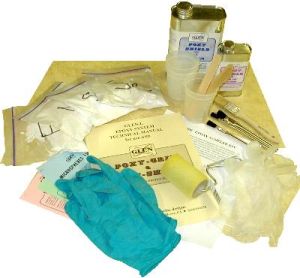
WebLetter 48
An Occasional Publication for the Home Boat Builder
Glen-L Marine Designs - 9152 Rosecrans Ave. - Bellflower, CA 90706
In this issue
- Tuffy: A first boating love by Cliff Steele
- On the Mark: Improvements - A Swim Platform by Mark Bronkalla
- A question about fiberglass
- Designer's Notebook: Using patterns
- Feedback: Airboat
- Inboard Hardware: Strut bearings
- Darla's corner
- Recent email
GLEN-L Update
- Web site:
- Things have been much slower than normal at Glen-L, but judging from comments on the news, we are not alone. We appreciate the support given by our customers and hope that you will remember us when you need epoxy resin or other supplies.
- Periodically I make comments about our computer problems under the assumption that if you are looking at this site, you are using one and may like to know that you aren't alone. I was in Oregon for two weeks and when I returned, my browser, Netscape, had upgraded and dumped email, address book, and email folders. Gayle forwarded email that needed to be answered and we continued. This week, it happened again. So, I just thought I'd mention that there is an alternative to Netscape (I wouldn't consider IE). The alternative that I have installed is Opera. It is faster that the other browsers and doesn't carry as much baggage as IE and Netscape and they offer a lot more support and resources. The program can be downloaded for free or you can buy it and get some extra perks. We have no financial arrangement with Opera, I just thought I'd share.
- Darla, our Office manager, is a regular browser of the Internet and frequently suggests things for the WebLetter. So... we have added a new section to the WebLetter, Darla's Corner. She would welcome any humorous tidbits from our readers.
- We would like to thank Mark Bronkalla, Cliff Steele, Charles Bailhache and the others who have contributed to the WebLetter. We haven't had any "Shop Talk" articles since Uncle Don in Kenai. If any of you have shop hints, I would be glad to put them in upcoming WebLetters.
Editor
Tuffy: A first boating love
by Cliff Steele
This article first appeared in the June 2003 issue of Heartland Boating and appears with the permission of the author.
Forty years ago this spring we built Tuffy our first boat. But before I talk about Tuffy, I must go back 50 years. I was 12 back then and enjoyed a hobby that later would lead me and introduce me to a life-long relationship with boating. I would spend long hours in our basement building model boats on an old rickety table, gluing and cutting little pieces of balsa wood, then painting them. I would load up the basket on my green Schwinn bike and peddle to the nearest Chicago park pond and launch them. The little boats would have small electric motors and flashlight batteries crammed below deck to make them move across the pond.
A TV series about this time named WATERFRONT was very poplar and starred Preston Foster. He was the Captain of a Harbor Tugboat named the Cheryl Ann. The plot was always lame, but I was drawn to the sturdy tug in all the harbor scenes. In real life the Cheryl Ann was actually a tug named Milton S. Patrick. Less than two years later the show was cancelled. Could it have been the curse of renaming a boat's original name? A model of Cheryl Ann was soon available in hobby shops and I bought the first, and perhaps last kit. It was all out of plastic, had real turned brass handrails, an electric motor and even included paints. I had found my new challenge, plastic model boating.
On the Mark: Improvements - A Swim Platform
by Mark Bronkalla
This spring we did some major work on our Riviera. The boat is primarily used for water sports and is left in the water all summer long. Between the UV exposure and the constant climbing over the hull, the varnish finish had taken a beating. This led to completely refinishing the deck and sides of the boat. We also wanted to enhance its use for wake boarding, skiing and tubing. For this we added a wakeboard pylon and swim platform. As you will see in the coming photos and articles, these items can play well with a classically styled boat.
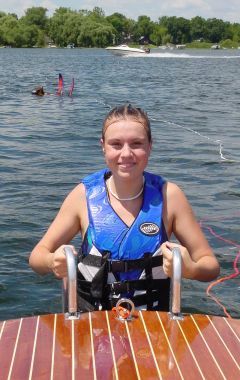
We had been entering the boat with a ladder attached over the transom. The ladder was removable and would fit into two clips at the top of the transom. Putting the ladder in and removing it every time we picked up a skier was a hassle. The ladder was in the way for waterski and wakeboard storage and was causing its share of damage to the boat. While the ladder was a huge improvement over simply hoisting ourselves over the sides (not easy at all), we wanted a swim platform as we had seen on competition ski boats.
This photo shows our daughter, Jessie coming up the ladder as it was mounted over the transom.
A question about fiberglass
Posted on the Boatbuilder Connection:
Posted by Ken on June 20, 2003 at 20:11:29:
I have been surfing websites pertaining to fiberglassing. I see S-glass,
biaxial cloth, and E-glass. I thought that if you arranged the fibers in a
45/45 direction as opposed to regular cloth, then you got E-glass. Then I ran
into a site that sold biaxial glass seperatly than the E-glass. Now I am really
confused, please help.
If that is not enough, I ran into a place selling chopped mat with a statement
"do not use with epoxy resin". Now I must ask if there is a
difference using epoxy resin as opposed to fiberglass resin (as far as the
cloth is concerned).
The following is taken from our book "How to Fiberglass Boats"
Chapter 3
Fiberglass Materials
The word "fiberglass" has virtually become a household word. Because this term is so common, and to keep things simple, it will be used in a generic way throughout most of this text. However, there are materials other than "fiberglass" that can be used for sheathing that will be discussed elsewhere in the text. For certain applications and uses, these other materials and their application processes may offer unique qualities not possible with fiberglass. The reader should review these alternatives, in addition to the text on true fiberglass materials and methods, so that the proper choices can be suited to his particular application. Therefore, keep in mind that the "fiberglass" sheathing process may not be the ONLY solution to a sheathing problem.
WHAT IS FIBERGLASS?
True fiberglass materials and the composite products made from them have suffered from a confusing abundance of names that, quite simply, refer to the same thing. Depending on the geographical area or who is talking, one might hear terms such as "glass-fibre", or "glass reinforced plastic", or "GRP", all of which are commonly used in England and Europe. In the US, one might hear the terms "fiberglass reinforced plastic", "FRP", "glass fiber", as well as the word "fiberglass", in common use. In all cases, these terms mean the same thing, which is the use of fiberglass materials usually in conjunction with some type of liquid plastic resin. Although the word fiberglass is often applied to polyester resin, it is the glass laminate material that makes it "fiberglass" and not the type of resin used to apply it. Yet few people know what fiberglass really is. Basically, it's a material made from glass filaments. With the advance of technology, many new types of glass filaments with high strength properties and other specialized characteristics are now available or in the process of development. However, due to economic considerations and the fact that most boats generally need only materials of medium strength with high rigidity, the type of fiberglass filament most often used in fiberglass materials for boat work is technically known as "E-glass", the "E" standing for "electrical grade".
For the technical reader, the actual glass used is a lime-alumina borosilicate glass of low alkali content with a high chemical stability and moisture resistance. This glass composition offers ample properties of flexibility, strength, and abrasion resistance under most marine conditions. Stronger glass compositions are made (such as high-strength "S-glass" which has about 20% greater tensile strength than "E-glass") but are more expensive, and availability of products made from them more limited. Unless added strength properties are critical, materials made with "S-glass" are not necessary in the majority of sheathing applications. This is a good place to mention that glass is applied to plywood boats to reduce maintenance and protect the surface and not to add strength. In a plywood boat, the strength is in the "wonder material", plywood.
Designer's Notebook: Using patternsWhen you purchase a set of GLEN-L plans, you receive patterns for various members as noted on the particular boat descriptive literature. These patterns usually consist of the exterior contour, often in half section, of the frames or sections, transom, and full templates of items such as the stem, knees, centerboard trunks or other pertinent structural members. These must be duplicated in wood, steel, aluminum or forms for fiberglass depending on the material the particular design is constructed of. Boats built by the Stitch and Glue method often furnish patterns for the planking and most contoured parts in the boat. Complete instructions are given on how best to use the patterns, but people often overlook or fail to review them adequately. There are several methods to duplicate the patterns to the material. The paper patterns can be laid over the material and a punch or awl used at frequent intervals along the lines to be duplicated. A dressmakers wheel, a round wheel with "teeth", works well on wood. We prefer carbon or transfer paper. Most are familiar with the old carbon paper used in offices but it's only standard paper size and lots of sheets are required. GLEN-L has recently made available transfer paper, in large 2' x 16' sheets that readily covers large areas in one piece. Patterns are frequently given in half section and a mirror image or opposite side is required. This is easily done with the transfer paper. Lay the half section pattern to be duplicated over the material used with duplicating side of transfer paper on the material and another duplicating side up to the paper pattern. Use a pencil and trace the contour. The line will be transferred to the material and the part mirror duplicated to the underside of the paper pattern simultaneously and both halves will be identical. The hole punching method will give the same results but the transfer paper is easier and gives a solid positive line on the material being duplicated. Many segments of patterns are straight lines. There is no need to duplicate these the full length of the line; mark the endings only, we use a well defined "dot" with a small circle around at either end of a straight line. When the transfer paper is removed the dots are connected with a straight edge directly on the material. |
Feedback: Airboat
The maiden voyage went well with the airboat. After the parking lot Christening, the "Glo Fly Bug", the trailer, and boat parted for the first time.
I was fortunate in having able-bodied seamen for the shakedown present as handling the airboat in itself took some nerve. After the run, all hands were far more relaxed and joyful.
We picked the marina at Suisun, California as the prevailing wind, and there's almost all the time plenty of that, blows down the launching ramp making the landing very controllable. At one point after shifting weight forward in the form of passenger/line handler we estimated our water speed at 40 miles per hour at 2,900 RPM, with still a lot of engine left to go.
Several items have been modified since the sea-trial and amongst them are, rudder linkages; bilge pump overboard discharge location; the addition of "SMART TAB" by Nauticus, Model ST980-40.
A few calls to airboat manufacturers assured me that Glen-L had it right with the engine being true 90 degrees to the flat bottom and not canted downward toward the transom to force the bow down for planing. All did recommend trim tabs on the airboat. The first problem encountered was the electric or hydraulic trim tabs were too long to install on the airboat transom as they required more virtual height than the Glen-L is designed to carry. The SMART TAB trim tab is compression spring operated and the tabs automatically adjust, an ideal situation of a pilot such as myself, the more I can concentrate on operational safety the better, no distraction to determine how the boat is trimmed or if it needs corrective action from the pilot/helmsman.
All in all, the whole project has come along with surprisingly few "Murphy's" so to speak. I did acquire some tools which will remain in my inventory for future projects, not all boatbuilding. The construction with aviation grade plywood's were my major construction concern. 3/8" plywood has 7 bonded/no flaw or plug birch ply's, the toughest plywood I have ever formed. The bow is right at the limit of the bow pieces. The forward portion has a lot of tension after gluing and screwing. I actually broke a white oak bow piece while pulling the plywood down. I would add the break was not at a long splice with two part epoxy but some four inches away. In my heyday of boatbuilding or rather shipbuilding, we did not have any marine glue as strong as the glues available now.
One item that could ease the difficulty of lacing with copper wire on say the rudders is to use abundant hog rings lightly squeezed so as to not penetrate the door skin but hold the adjoining sides while the glue sets. Works like a charm.
I opted to include a lazerette on the foredeck with a commercial plastic and latching lid. I keep the anchors, handling lines, medical kit, tools, flares etc., etc. as well as three cubic feet of canned blue Styrofoam on both sides of the center locker.
Prior to launch, the Vallejo Coast Guard Station inspected the airboat for seaworthiness and boating regulations. The airboat being under 16 feet made meeting the minimum requirements easy. The engine is not enclosed and an extinguisher is not required though one is attached to the front seat. A horn is not required but installed, the lights include navigation green/red/white and a yellow strobe for daytime use. This invoked some praise for the issue of safety from the Coast Guard. In addition to a can and sponge there's a 700 GPH bilge pump which brings me to an earlier problem with the write up of the boat plans. No mention is made of the draft with the VW engine, a battery, gasoline and also a 230 pound pilot. Where I had calculated to water line at rest to be was only two inches above where it actually is at the transom. The bilge pump exhaust had backwash flowing into the seat area at the stern. When the bilge pump was run it drained the boat quickly. While underway the taking on water disappeared as the stern quickly rose clear of the at rest waterline. Anyway I plugged the hole and will wait until all the testing is complete to drill another inch hole through the hull, this time well above the waterline.
Well folks its late and I must cease this letter and climb into my rack and get some slumber, morning watch comes all too quickly.
Sincerely, Charles A. Bailhache a Happy and Satisfied customer
6-24-03 PS: Need some smooth water for a real speed run, got up about 40 MPH with the GPS as an indicator but Mare Island is too rough and wave action is in all directions at once. Next stop, Oakley and the delta with some fishing gear.
Inboard Hardware: Strut bearingsWe often get questions or orders that indicate that many builders installing inboards do not understand how bearing are installed in our struts. Other manufacturers have other methods for installing bearings, so the following may not apply to products from other manufacturers. The strut "barrel" or housing into which the bearing is inserted can vary in length. The bearings are available in only one length. They are not meant to be the full length of the barrel. One bearing is installed in a strut. It is cut in half and one half is inserted in each end of the barrel. We will install the bearing at no charge if it is ordered at the same time as the strut. If for some reason you need to install the bearing
yourself, this is how it can be done.... |

Darla's corner
by Darla Schooler
I am always on the lookout for bits of information that might inform or amuse the readers of the WebLetter. Starting with this issue, Darla's Corner will become a regular feature. If anyone has any contibutions, I will gladly accept them. Darla Schooler
What is the origin of the term "poop deck"? Well, it's not what you think. Poop deck comes from the Latin word puppis, which means "stern". A poop deck is a raised deck at the rear of a ship.
![]()
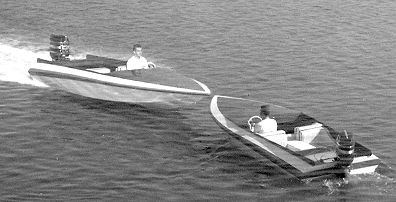
Please don't try this at home. This was done by professionals.
![]()
Recent email:
Subject: V-dory
Date: 7-16-03
...
By the way, I am finished with fiberglassing the hull and want to tell you
your video
on glassing boats was a wonderful help. It was the single most helpful bit
of instruction I have yet received in this project.
Thanks for your help. - Dave Holmes
Subject: Swish builder
date: 7-16-03
Friends,
Friends,
Just wanted to tell you how excited I was when I accidentally stumbled across the "Swish" pictures on your site because I built one of those boats in 1958 for my 9th grade shop project from the plans that were in Popular Mechanics. That was such a swell looking design at the time that I just had to have one! This was a pretty steep undertaking for a kid of that age, but I did finally finish it in another year or so and have a couple very fuzzy old pictures to prove it. Seeing these pictures really swept me away! This was the first of many ambitious, but successful projects over the years. While challenging at the time, these endeavors build the character and confidence in us for successful futures!
I would strongly recommend any project like this as a great suggestion for a Father & Son project. This is one of the few remaining opportunities we have as parents to pass on our work ethic and skills to a "hi-tech" generation. I did this with my son when he was 14 from which he gained the seldom found self-sustaining capabilities to pass on to his 2 children when they get out of diapers.
Thanks,
Tom Barrick
Subject: just amazed
Date: 7-8-03
hi;
I recently purchased a set of plans and full size patterns for your Tornado,
along with your "how to fiberglass boats", "boat building with
plywood", and your "inboard motor installations" books. I am
truly amazed at the quality of the package that arrived and it has far exceeded
any expectations I had. The completeness of the information has convinced me
that I am capable of completing this.
Thank you for your well thought out product.
Duane Wood
Below is the result of your feedback form. It was submitted on Monday, July
7, 2003
----------------------------------------------------------------------
name: gunther muhsemann
Comments: I built 3 of your designs including TANGO. I'm now 82 years old and still enjoy sailing "T" occasionly.
Subject: Thanks
Date: 6-6-03
Was at a loss to cheaply true up some maple boards that were off prior to gluing them up and did a lookup on "truing edges". Your diagram of the table saw jig saved me some time and/or bucks, 'cause I was going to either get a plane out and do a crappy job or take 'em to somebody with a real shop and pay them to do it.
Thanks,
Ben
For Sale: Modified Raven
19 June 2003
Dear Mr. Witt,
Since the death of my husband in 2000, I have been unable to contemplate giving up his creation "Chêneterre". We loved her dearly and John-- who you might recall, built her alone, starting in 1995 and finishing the job at age 80, was always proud of your approbation. Do you know anyone who would be a potential buyer? This modified Raven is 25', with a different approach above the waterline. I am asking $37,000. She has known only 9 weeks in the water,but those 9 weeks were bliss.
Thank you,
Constance Ecklund
Woodbridge, CT
Includes 50 hp O/B with handler, fully equipped canvas. The boat has been surveyed. We have one photo that was sent in when the boat was completed. Photo.
Posted by Brian on July 01, 19103 at 06:48:44:
Recently the Glen-L-builders group based at Yahoo groups changed format from
a Glen-L-specific group to a general boatbuilding group. If anyone is working
on a Glen-L project and would like to be involved in discussion specifically
related to Glen-L, there is a new group forming. The home page is:
http://groups.yahoo.com/group/BoatbuildingGlen-L/
So come and join!
Thanks,
Brian
Subject: Re: Sea Kayak
Date: 7-2-03
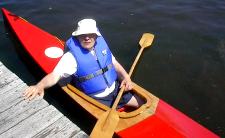
Hello Barry,
Believe it or not, I have become a paddler of the neatest boat I have ever
owned. (The only one also) We launched our 17ft. sea kayak, the "Sea
Cookie" yesterday, the 1st of July, 2003, Canada Day. With home made
paddles and all it is a wonder to paddle. All that tried it thought it was
great and "fast". At 63, I don't need the speed but it is great
fun. I look forward to improving my health with this great machine. Thanks for
the wonderful plans. Even I, a novice wood worker could follow them and do it.
A few pictures for your records of another Glen L. Design happy builder.
Cheers, Mike Cooke.
Subject: Lumber supplier
Date: 7-1-03
Sir, in response to your web site. My name is Red Esslinger DBA Mnt. Man Cutting of PO 19551 Thorne Bay Alaska 99919 (907)828-8880 FAX (907) 828-8895 I am a producer of the very finest grain, highest quality old growth rough sawn (ad) Alaska Yellow Cedar, western Red Cedar, Sitka Spruce and Western Hemlock. Shipped to Seattle weekly via Boyer Barge. Please let your readers know of this great product for those who choose the best. Red Esslinger
Subject: Re. Hunky Dory with Cabin by Lee Walker
Date: 6-22-03
6-22-03: Well didn't make it by 4/7/03, but have finished painting, and am building a beam overhead, I will be rigging a sling for turn over. The plan is to lift the boat, with a come-along (10 ton). The come-along will be attached to a 4X12 beam, and will have a pulley attached to run the sling through. I have cut out the strong back of the framing form at the (hopefully) balance point and am going to attach 2 - 2x6's side to side to keep the pressure of the sling from deforming the sides. Then I will lift, remove the framing forms, rotate the boat to upright, and lower on to the trailer. One suggestion for those of you who are building in a "reduced width" space, build bow toward the door, the boat will not fit worth a hoot on the trailer backwards. I retire next week so hopefully will have time to put towards the boat. I am still having trouble coming up with a name... any reader suggestions?
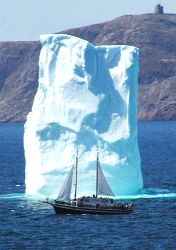 Photo
Karen Chappell, www.Bitstop.ca Photo
Karen Chappell, www.Bitstop.ca |
Mike is building the Sea Kayak.
Subject: Sea Kayak
Date: 6-24-03
Just to let you see what we have to kayak around. Cheers, Mike Cooke
Below is the result of your feedback form. It was submitted on Monday, June
30, 2003
--------------------------------------------------------------------
name: Richard P. Stickney Jr.
Comments: Have built the IMP and the GLEN-L 12 in the past and am looking at
the STRIPPER. Both previous projects were successful and FUN. I built the
GLEN-L 12 with my son many years ago and spent many years sailing it on local
lakes. The memories we shared will last a lifetime and for that opportunity I
cannot ever thank you enough. Congratulations on many years of service to the
rest of us amateur boat builders.
Below is the result of your feedback form. It was submitted on Monday, June
23, 2003
----------------------------------------------------------------------
name: Richard Jorgensen Sr
Comments: I like your designs and the easy way to move through your web-site. I
bought the plans for your Drifter some time ago, and though I have not yet
built it, I was very impressed with package. I have been a Drafter for almost
30 years and I know good layout work when I see it.
Subject: Re. Topper
Date: 6-10-03
Barry,
The topper is done! Launched it last saturday. My neighbor asked me where i
bought it, and I proudly said, "actually, I MADE it".
Robert B and Robert C Rawlings
Below is the result of your feedback form. It was submitted on Saturday,
June 7, 2003
----------------------------------------------------------------
name: Yehezkel Yeskin
Comments: I have spent many sailing hours on your design 21CB and on voyages of
few days and nights. As a sailor from 1982 and owner of bigger wooden boats
(26' & 33' long), I know how to appreciate the good seaworthiness
of the Glen-L 21. I like also your catalogues and boat plans that I purcased
from 1977 every few years, and one day I may build a boat from your design.
Thank you for all.
Build more boats
GLEN-L boats, of course
